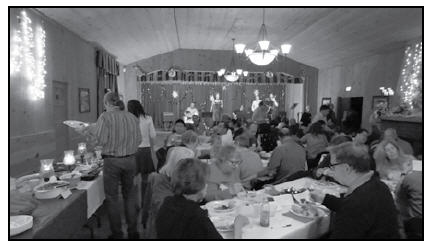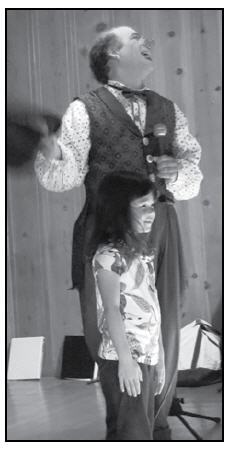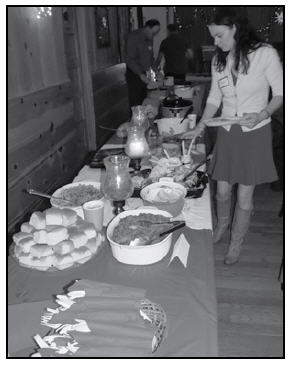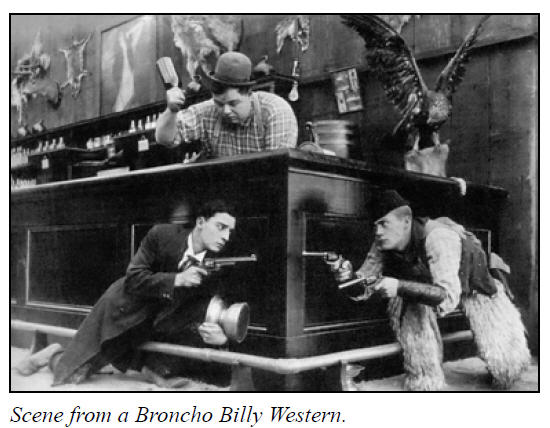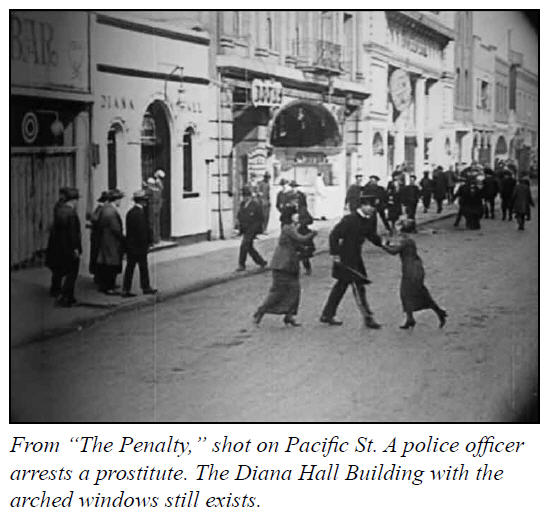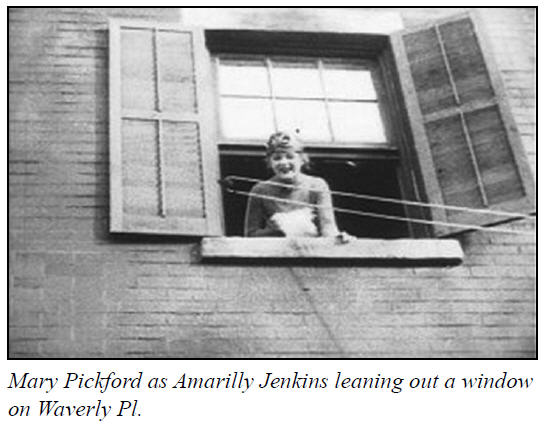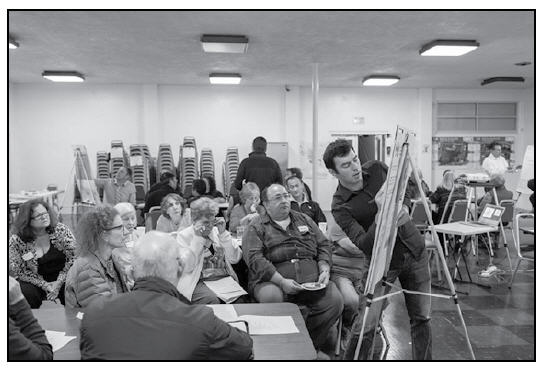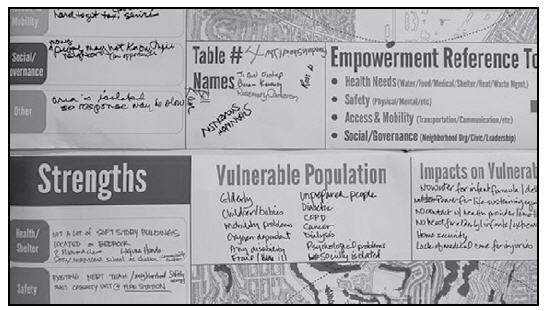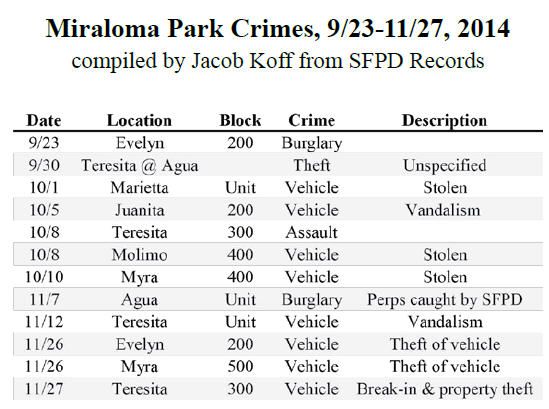News & Events
Miraloma Life: January 2015
- 22nd Annual MPIC Holiday Potluck Party Just Grand
- Silent Film: Born and Raised in San Francisco
- From the President’s Corner
- Summary of MPIC Board Meeting of December 4, 2014
- San Francisco Readies for the Big One, a Block at a Time
- Why I Joined the MPIC
- Money Matters: HSAs—A Way to Save and Spend Tax-free
- Miraloma Park Crimes, 9/23-11/27, 2014
22nd Annual MPIC Holiday Potluck Party Just Grand
by Dan Liberthson
The Laura Lee Brown & Company Band played and sang, Boswick the Clown clowned around, kids and adults laughed, and everyone ate themselves silly on wonderful homemade dishes. Attended by about 100 festive and feasting Miraloma Park neighbors, the Holiday Potluck was grand. Many thanks to Board Members Carl Schick, event organizer, and Kathy Rawlins for her beautiful mantelpiece decorations, and to all the other MPIC Board Members who worked hard to make it happen.
Dish, Place, Winner
Appetizer: 1st. Gary Isaacson, Meatballs 2nd. Shannon Chu, Potsticker
Side Dish: 1st. Michael Fox, Holiday Green Salad 2nd. Quinoa, Sue Kirkham 3rd. Sweet Potatoes, Joanne Whitney
Main Dish: 1st. Diana Rohrer, Plain Mac & Cheese 2nd. Becky Yee, 5-Cheese Mac & Cheese 3rd. Mark Jawgiel, Pulled Pork
Dessert: 1st. Patty McCormack, Bread Pudding 2nd. Marilyn Grassman, Strawberry Almond Flan
3rd. Pam Chan, Panne Cotta
Silent Film: Born and Raised in San Francisco
By Jim O’Donnell
Most people are unaware of the important place SF and the Bay Area hold in the development of the film industry, starting just over 100 years ago. Many major silent film stars were born or got their start here, including Roscoe (Fatty) Arbuckle, Charlie Chaplin, George O’Brien, and Lon Chaney Sr, The Man of a 1000 Faces, who made The Phantom of the Opera famous. SF had the most live-performance theaters (vaudeville, musicals, comedies, tragedies) in the western US in the late 1800s, and then led in the rise of the silent films that supplanted them. By 1920, 20,000 theaters in the US showed only silent films.
Motion pictures began in SF in 1879. An English photographer, Edward Muybridge, was hired by Leland Stanford to prove that all of a galloping horse’s hooves completely leave the ground at once. A series of photos resulted, shot from camera stripped as the horse passed. Riffle the photos, and the animal appears to move like a live horse. An inventor too, Muybridge developed the first motion picture projector, the zoopraxioscope, and showed his photos of the horse on a disc. He later made other sequential photos at his studio at the SF Art Association near Kearny and Pine, including those of William Lawton, Olympic Club gymnast, making him the first “movie star” in the early 1880s!
Motion pictures were at first a novelty, shown at live theatres as the audience left after the show. In 1903, The Great Train Robbery, a Western filmed in New Jersey, started a new era. Referred to as a “short” because it was on one reel with a maximum of 17 minutes of film, this film became so popular that shorts became featured parts of theater offerings. One extra in the film, Gilbert M. Anderson, later greatly influenced the growth of the film industry in the SF Bay Area as the first “Western” star: Broncho Billy Anderson.
Anderson later teamed up with businessman George Spoor (Spoor and Anderson), who held patents on early film projectors. Moving out from Chicago headquarters, Anderson used several venues in California, including Marin and Santa Barbara. Cranking out 148 “shorts” from 1912 to 1915, Broncho Billy set the standard for movie westerns at his Niles Essanay Studio, now part of Fremont. Early on he signed Charlie Chaplin, who developed his “Little Tramp” character under Broncho Billy Anderson’s direction.
Until 1906, the many film studios in SF made it the business hub of the entire Pacific Rim. The Great Earthquake of April 18, 1906 changed that forever. The famous film A Trip Down Market Street was shot only 4 days before the quake and the unprocessed film sent to New York on Apr 17. You may want to visit Niles, where silent films are shown every weekend at the original Niles Theater
Many know that the great tenor Enrico Caruso was in SF performing at the Opera House before the Great Quake. Less known is his discovery of silent film actor Roscoe Arbuckle, whom he urged to pursue an operatic career because of his fine voice. Arbuckle was a singing waiter in SF and San Jose when David Grauman, the great theatre impresario, recruited him for his live theater venues. Arbuckle was then hired by Mack Sennett of Keystone Studios in Los Angeles as one of the original “Keystone Kops.” Noting his comedic and acrobatic talent, Sennett featured him, marketing him as “Fatty” because of his 300 lb. weight.
Fatty Arbuckle became a bellwether for the film industry, one of the biggest comedic stars in the world, earning $1 million a year in an era when you could live comfortably on $2,000. He had six Pierce Arrow cars, reportedly costing $35,000 each. To see Arbuckle and Mabel Normand, who often starred with him, in a promotional short for the Panama-Pacific Exposition in 1915, search for Mabel and Fatty at the Fair on the Web.
Fatty liked to party in SF, so for his birthday around Labor Day, 1921, he called Maude Delmont, his connection for women here. He brought two cronies and stayed in Suite 1219 at the St. Francis Hotel. On Saturday night, with the liquor flowing, Arbuckle’s consort Virginia Rappe passed out. The hotel doctor suggested that she sleep it off. The next day she was hospitalized, probably due to a prior infection that led to peritonitis and death 3 days later. Arbuckle was fingered by Delmont as responsible for Rappe’s death. The police asked him to appear in SF for questioning, where he was arrested without bail. Matthew Brady, the DA, sought political hay, as he aimed at the governor’s mansion. After three trials, Arbuckle was acquitted, but his movie career was over and he was flat broke. The case led to the Hays Code ten years later, which clamped down on the film bawdiness blamed for America’s moral slide. Arbuckle managed to stay active as a screenwriter and director until his death in NY in 1934.
Several major theater owners who started in SF later moved to Southern CA, where Grauman’s Chinese, Egyptian and the Million Dollar theaters became land marks of the golden age of film. Impressario Sol Lesser made his own movie in 1913 called The Last Night of the Barbary Coast, presaging the statewide Red Light Abatement Act of 1917 that ended the bawdy era in SF. Lesser eventually owned 100 film theaters and retired a young man in 1925, but tired of inaction and began to produce films, including the famous Tarzan, the Apeman series starring Johnny Weissmuller.
Jack Warner, who later built Warner Brothers into one of the Big Five film studios based in Southern California, made his first film in SF, a one-reel comedy at Seals Stadium called The Bleacher Hero, and owned his first theater, the All Star, at Sutter and Fillmore Streets. In 1927 Warner Brothers bought Vitaphone and made the leap into the sound era. Using the stage of Coffee Dan’s basement speakeasy at O’Farrell and Powell, they filmed The Jazz Singer, featuring the first spoken words on film, “You ain’t seen nothing yet!” though most of the film was silent. Within 3 years, silent movies were a thing of the past. Notably, the geographic alpha (Pine and Kearny) and omega (O’Farrell and Powell) of silent film occurred within walking distance of each other in downtown SF.
This article provides a sampling of The Silent Film Tour, one of nearly 100 different free tours offered by SF City Guides. Developed and initially led by Rory O’Connor, a veteran raconteur who has created many tours, the silent film tour is now also guided by Jim O’Donnell, author of this article. Offered on the 2nd and 4th Saturdays of each month, the tour leaves at 2 pm from the corner of Kearny and Pacific, the last remnant of the Barbary Coast, and ends at 4 pm at Union Square in front of the St. Francis Hotel. At www.sfcityguides.org, you’ll find thumbnail sketches, schedules, and locations for all of SF City Guides’ free, volunteer-led walking tours throughout SF. They are a great way to learn SF history and visit important historical locations from the Gold Rush to recent times. We hope to see you soon!
From the President’s Corner
by Robert Gee, MPIC President
Happy New Year, everyone! In 2015 I want to lead the Miraloma Park Improvement Club (MPIC) with renewed energy toward our community goal of making our great neighborhood even better and safer. I’d like neighbors to get to know one another and work toward our community goal: better quality of life for everyone. OK—I’m an optimist, and my glass is always half full!
For me, 2014 was a difficult year. Many friends struggled through serious health and financial issues. I made it through the year intact because I’m blessed with a wonderful family, good health (from racing in marathons and triathlons, getting whipped by fellow Masters-age participants), awesome coworkers, and the chance to work with a fine group of dedicated MPIC Board Members and city officials who come through when you need them. But what I remember most vividly were the wonderful opportunities I had to meet and work with so many neighbors who truly care about our community. They took the time to show their support on neighborhood issues and participate in the MPIC activities, especially our historic Resilient Miraloma Park initiative. Kudos to them, but much work remains (so my glass is also half empty?).
Many residents ask me “What does the MPIC do? I know it delivers a monthly newsletter but I thought it’s just a social club so why join? It does something with zoning and how our houses look, and it tries to keep our neighborhood safe, right?” When longtime residents ask questions like these, I’m most puzzled, but this just means the MPIC needs to communicate better what it does and how it benefits residents.
Created in 1936, the MPIC does publish a monthly newsletter, hold social events, actively engage in zoning issues, and work closely with the police—but, as a nonprofit neighborhood organization dedicated to improving the outstanding quality of life in Miraloma Park, it does a lot more. Our volunteers, some newcomers and others who’ve lived here for decades, work on a broad range of issues with neighbors, the Mayor’s office, our District Supervisor, and many city agencies. The Club relies on Miraloma Park residents to help us ensure that our neighborhood is a safe and comfortable place to live. Here are a few Club activities you could help with:
Neighborhood Resilience. Last year, we launched Resilient Miraloma Park—an initiative to ensure we are prepared for disasters and will recover quickly. After several community meetings, with input and support from many residents, we drafted an action plan. In 2015 a Community Working Group will prioritize our objectives and put these ideas into action. I’m proud that Miraloma Park was prominently mentioned in a Nov 20 piece in the Wall Street Journal about how neighborhoods are working to be self-sufficient in emergencies (see article in this posting).
Development. The MPIC Board works hard to preserve the suburban urban character and zoning of our single-family-zoned neighborhood. Volunteers attend hearings, write letters, and make public comments. We help developers and planners keep new construction and home expansions consistent with the design of surrounding homes and maintain the architectural character and charm of our neighborhood. In 1999, the MPIC wrote the Miraloma Park Residential Design Guidelines, adopted by the Planning Commission and on our website at miralomapark.org. We try to make sure that these guidelines are understood and followed.
Safety. The MPIC has zero tolerance for criminal activity. Our neighborhood is one of the safest in the city but it’s not crime-free. Maintaining a strong working relationship with our police, district attorneys, and city attorneys takes a huge volunteer effort to attend meetings, write letters, send emails, and make phone calls to advocate and hold city agencies accountable. But this commitment is invaluable in preventing crime in the neighborhood.
Traffic. The winding streets of Miraloma Park were designed for a time when city traffic was much less congested. Teresita Boulevard is like a freeway now: too many drivers, many from our neighborhood, don’t obey speed limits and traffic signs. The MPIC Board works diligently with city officials to reduce speeding, calm traffic, and increase pedestrian safety—an ongoing effort often frustrating but essential to neighbors’ well-being.
Communication. Miraloma Life is our primary means of communication with Miraloma Park residents. Since 1940, it has been delivered to 2,200 homes! Our website is a more recent resource, and we invite you to tell us how to improve it. We also reach out through the private website Next Door Miraloma Park at https://nextdoor.com/neighborhood/miralomapark–san-francisco–ca/ distribute the newsletter by email, send out email notifications, and post signs about events.
Beautification. Graffiti vandalism and urban blight are not tolerated in our neighborhood. Removing tags and getting homeowners, businesses, and city agencies to keep their property free of these scrawls is a never-ending chore, but the MPIC’s volunteers try to consistently and swiftly eradicate graffiti as it appears. The quicker it is removed, the less likely it will reappear. We encourage residents not to concrete in their front yards, but keep the charming gardens that beautify our streets. And we’re also forming a resident coalition to work on improving Miraloma Playground.
We could use your help in any of the above areas and more. How can you get involved? The MPIC Board works directly with the Mayor’s office and the office of our supervisor, Norman Yee, on issues of importance to Miraloma Park. In politics, more members means a stronger voice and better results. With only 500 members, less than 25% of households in Miraloma Park, the MPIC’s voice is not as strong as it could be. So Step 1 for helping is to join the MPIC—no financial hardship at as low as $12 a year.
We build membership throughout the year, but in January we make a special effort. I invite everyone to join or to renew your membership in the MPIC: Either mail in your annual dues and membership form in the envelope inserted in this newsletter, or join on line at miralomapark.org/about/join/. Starting with Bill Kan’s article in this newsletter, in the future we’ll publish comments from members as to why they joined MPIC.
Summary of MPIC Board Meeting of December 4, 2014
Speaker: Joe McFadden, Ingleside Precinct Captain, reports Miraloma Park is one of the safest SF neighborhoods, plagued mainly by car break-ins and packages stolen from doorsteps. Best deterrents vs home breakins: a dog, video cameras with posted notice, an alarm system, good home-front lighting, and knowing neighbors. Immediately call police re anything or anyone suspicious.
Motions Approved: Spend $125 to sponsor CSFN annual dinner; give year-end bonuses of $300 to Rental Agent, $65 to each of four newsletter deliverers, and $150 to newsletter designer ($660 total); spend up to $300 on Holiday Party gift card prizes.
Treasurer’s Report (T Sauvain): Net worth in Nov: $21,181, down $1408 from Oct. Rental income: $4505 in Nov vs $3240 in Oct. Current reserve total: $7895.
Committees: Membership (B Kan)—490 MPIC members on 11/30, vs 514 on 10/31. Membership reminders via MailChimp begun. Clubhouse Maintenance (K Rawlins)—$895 fireplace gas unit insert successfully repaired fireplace. Safety (Committee)—Working to abate camping on Mt. Davidson and get illegal Mt. D dumps removed with help of Sup. Yee’s aide Olivia Scanlon, SFPD, and Rec-Park Dept. Streets and Transportation (K Breslin)—Stop-sign installation at Teresita and Bella Vista to be discussed. Planning (T Armour)—Delvin Washington, Planning Dept, contacted re remodel at on the 300 block of Teresita; will follow up with sponsor. Resiliency (R Gee, D Homsey)—R Gee and K Wood met City officials and SF resiliency groups to assess and promote overall emergency preparedness. Miraloma Park Resiliency Working group to meet monthly from Jan.
Community Organizations: Coalition for SF Neighborhoods (CSFN), 11/18 (K Breslin)—First District Court of Appeals decision on the Park Merced development favors development interests; concerns Prop M (1986) requiring sufficient transportation for new construction is being circumvented. AirBnb debate activated many groups—important for future City preservation issues. West of Twin Peaks Central Council (WTPCC), 11/24 (K Breslin)—Phil Ting, Assembly, unhappy with community college oversight Commission and UC fee increase. Sunnyside moved WTPCC write Planning Dept supporting Monterey Blvd Safeway renovation (passed). Motion supporting opponents of e-cigarette outlet at 1963 Ocean Ave failed.
Old Business: R Gee seeking co-chairs for committee to lead Miraloma Elementary Playground renovation.
New Business: District 7 Participatory Budgeting opens Dec 8; submission of project ideas (eg, park, traffic, pedestrian safety improvements) due by Mar 2015. Complaints that bright SOTA sign (Portola @ O’Shaughnessy) shines in bedroom windows at night; Board to investigate.
San Francisco Readies for the Big One, a Block at a Time
by Jim Carlton (jim.carlton@wsj.com . Reprinted from The Wall Street Journal with permission)
Neighborhoods in Some Cities Work to Be Self-Sufficient in Case of Emergency
Resilient Miraloma Park, a neighborhood group that meets to discuss disaster preparedness and mitigation plans, at a meeting in San Francisco this month. JASON HENRY FOR THE WALL STREET JOURNAL
San Francisco—If a devastating earthquake were to hit this city, local officials hope to deploy a new weapon: residents trained as emergency response teams to help neighborhoods fend for themselves until water and other services are restored.
“We need to be ready to go the distance, like five days,” said Daniel Homsey, director of the city’s Neighborhood Resilience program, which so far has organized volunteer teams in three communities.
This effort and other, less-formal ones across the nation come in response to severe natural disasters in recent years, which public-safety coordinators say have highlighted the inability of government agencies to respond immediately in certain situations. As a result, more Americans are being told they will have to rely on their own means to survive in the first hours or days following a catastrophe.
In San Francisco’s Bayview neighborhood, for instance, resilience coordinators have handed out door hangers that residents can put out signaling whether they need help after a disaster, and are talking to local ham radio operators for help in emergency communications. “My feeling is the fewer people have to call 911, the better,” said Anietie Ekanem, a 41-year-old social-media consultant and neighborhood leader.
Maps hang on the wall at the Resilient Miraloma Park meeting, used to identify issues in that San Francisco neighborhood related to mitigating a disaster.
San Francisco is among 10 U.S. cities that have signed onto a program called 100 Resilient Cities started last year by the Rockefeller Foundation. Other American cities include New York, Los Angeles and Boulder, Colo., while international cities include Rio de Janeiro, Mexico City and Melbourne, Australia.
Michael Berkowitz, a managing director for the foundation, said the program was created after emergency-response officials began noticing close-knit neighborhoods in places like New Orleans after Hurricane Katrina and New Jersey after superstorm Sandy rebounded faster from the disasters than the ones where neighbors didn’t know one another.
The resilient neighborhoods basically work out emergency-response plans such as having food and water cached at a community center in case of disaster, rather than wait for outside help. They are also better positioned to work with local government to rebuild, Mr. Homsey said.
“It’s not just about the response of government, but also neighborhoods being more cohesive,” said Mr. Berkowitz, former deputy commissioner of emergency management in New York.
The resiliency trend is being manifested in other ways.
The Department of Housing and Urban Development, for example, said it would award $1 billion to communities that have been hit by natural disasters from 2011 to 2013. A total of 67 state, local and U.S. territorial agencies hit by the disasters are eligible for grants tied to their proposals for recovery, such as revising building codes so a community is better prepared for the next calamity. “This is the future of planning practice, really,” said James Brasuell, managing editor of an urban-planning blog called Planitzen. “We’re only seeing the beginning of that trend, I would say.”
The resilient cities face different challenges. Boulder has a large population of college students who may not realize the city lies in a flash-flood area, said Greg Guibert, who recently was appointed the city’s chief resiliency officer, a position being funded by the Rockefeller Foundation.
“Let’s be honest: Young people are not necessarily the most responsive to being ready for emergencies,” Mr. Guibert said.
Even in more established neighborhoods, resiliency plans don’t always work as envisioned.
When a magnitude 6.0 quake rocked her out of bed in San Francisco on Aug. 24, Jeanette Oliver wanted to alert a new resiliency team she had joined—but didn’t know whom to call.
“I didn’t know who was in town, who to deploy,” said Ms. Oliver, a shopping-center manager in San Francisco’s Diamond Heights neighborhood, in a meeting of a group there afterward. “I really felt we missed the boat.” The quake struck 60 miles to the north in Napa, Calif., so caused little damage in San Francisco. Her group resolved to put together an emergency contact list, after the quake left the city with little damage.
San Francisco’s current resiliency initiative began in 2007, when Mayor Ed Lee, then the city administrator, saw how better-organized New Orleans neighborhoods had recovered faster after Katrina. Mr. Homsey went on to begin deploying citywide readiness plans in three initial neighborhoods, where residents help craft their own post disaster plans, as well as ways to mitigate the impact.
“We want to hear your craziest, kookiest ideas,” Mr. Homsey said at a September meeting of a Miraloma Park neighborhood group in a church basement.
While the Miraloma plans are being finalized, neighborhood leader Robert Gee said ideas have included everything from stockpiling communal food and water to holding more block parties for people to get acquainted. “The big overarching thing is, How do you get to know your neighbors, so you can do things like plan ahead to help the most vulnerable seniors?” said Mr. Gee, 53, president of the Miraloma Park Improvement Club and a federal agency manager.
Taking stock of the Miraloma proceedings was Randy Brawley, a preparedness analyst and planning officer for the Federal Emergency Management Agency.
Mr. Brawley, who is based in Oakland, said such community response can only help emergency agencies such as FEMA. “The bottom line,” Mr. Brawley said, “is it takes a finite amount of time [for government agencies] to reach citizens when responding and recovering from a disaster.”
Why I Joined the MPIC
by Bill Kan, MPIC Director
My wife and I learned of the MPIC before we moved to Miraloma Park from Sue Kirkham, Board member and realtor. She told us about the Club’s social activities and long history of making this area a great place to live. Newly moved in, we thought joining would be a good way to meet neighbors, but it wasn’t long before the Club helped us in other ways. Not realizing how crazy traffic can be around Miraloma Elementary, we were lucky to meet Robert Gee, MPIC’s President, who welcomed us and told us about how to handle the traffic and parking situation. That was just our introduction to the MPIC—later we’d benefit a lot more from its activities.
Residents are welcome to attend MPIC Board meetings on the first Thursday of every month. I attended and learned how the Club’s many activities make living here so enjoyable. The all-volunteer Board and committee members help make the MPIC an active advocate for our neighborhood by partnering with City agencies, other neighborhood groups, and neighbors. Now that we have lived in Miraloma Park for over a year, we understand why so many have established deep roots here. My wife and I have gotten to know many wonderful neighbors at various MPIC social events. We participated in Resilient Miraloma Park, the community-based program to handle crises that has caught the eye of the Federal Emergency Management Agency (FEMA) and is featured in the Wall Street Journal article included in this newsletter. We learned why Miraloma Park has so little graffiti, and highly appreciate the Club’s efforts in the areas of safety, senior programs, traffic issues, and preservation of open space and architectural integrity. The MPIC is a unique organization that gives so much to our community, and I am happy to serve on its Board!
Money Matters: HSAs—A Way to Save and Spend Tax-free
By Bill Kan, CFA
Thanks to all who responded to my Money Matters article in the December issue. This month, we take a closer look at Health Savings Accounts (HSAs). This article should be used for informational purposes only and should not be viewed as investment, tax or legal advice.
As large and small employers seek ways to contain healthcare costs, HSAs are gaining in popularity. One strategy is to increase participation in high-deductible health plans (HDHPs) with lower premiums. In conjunction with a qualified HDHP, many employers set up HSAs with trustees for employees. Employees can use HSAs to set aside pre-tax money that they can withdraw tax-free to pay for qualified health care expenses. Unlike the Flexible Spending Accounts discussed last month, HSAs are not subject to an annual “use-or-lose” requirement. Employers offering HDHPs with HSAs increased from 12% in 2010 to 26% in 2012, according to the Kaiser Family Foundation. People who buy their own health coverage can also establish HSAs if they have a qualified HDHP.
HSAs are like medical IRAs with features of both traditional and Roth IRAs. Contributions are tax deductible. Interest and other income are not taxed. As in Roth IRAs, distributions are tax-free if used for qualified medical expenses, and there are no required minimum distributions after age 70.5. Employees own their HSAs, and money left over is transferred to beneficiaries assigned by the owner. HSA balances belong to the employee if they leave their employer. For 2015, the maximum contribution is $3,350 for individual coverage and $6,650 for family coverage. Participants between age 55 and 65 can make additional catch-up contributions up to $1,000. Sounds great so far, but HSAs come with some caveats. To be eligible, you must be covered by a qualified HDHP with minimum deductions in 2015 of $1,300 for single and $2,600 for family coverage. No other health coverage is permitted (with certain exceptions), and you must not be on Medicare or a dependent on someone else’s tax return. Distributions for non-qualified expenses are possible, but subject to a 20% penalty. For details, search for and download irs.gov/pub/irs-pdf/p969.pdf.
If there is a tax-free way to grow and use savings, I want to know more. It’s little known that the IRS permits a wide range of investments for HSAs, including stocks, bonds, ETFs, mutual funds, and more, that have higher growth potential than cash. Most people do hold cash, a prudent choice, but other options may be available: check with your employer or HSA trustee. Non-cash options may offer opportunities to use HSAs as a vehicle to grow savings tax-free, with potentially tax-free withdrawal. HSAs also may be a good way to maintain emergency cash to use during job transitions or unemployment, as withdrawals are tax-free when used to pay for continuing healthcare coverage while receiving unemployment benefits or under COBRA. HSAs can also be a powerful tool to address long-term healthcare concerns, as withdrawals are tax-free for qualified long-term care expenses or premiums for long-term care insurance.


